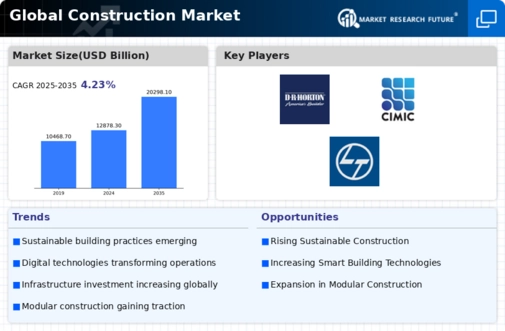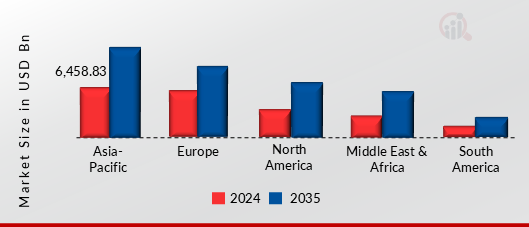Construction Size
Construction Market Growth Projections and Opportunities
Construction Market Size was valued at USD 8215.8 Billion in 2022. The Construction industry is projected to grow from USD 8626.5 Billion in 2023 to USD 12745.4 Billion by 2032, exhibiting a compound annual growth rate (CAGR) of 5.00%
The construction market is influenced by a myriad of factors that collectively shape its growth and dynamics within the global economy. Economic conditions, technological advancements, regulatory changes, and societal trends all play integral roles in shaping the construction industry. One of the primary drivers impacting the construction market is economic stability. During periods of economic growth, increased investments in infrastructure, commercial, and residential projects contribute to the expansion of the construction sector. Conversely, economic downturns may lead to reduced construction activities due to tightened budgets and decreased consumer spending on real estate.
Technological advancements are pivotal in transforming the construction landscape. Innovations such as Building Information Modeling (BIM), advanced construction materials, and digital tools have revolutionized the way projects are planned, designed, and executed. BIM, for instance, enhances collaboration among various stakeholders, streamlines project management, and improves overall efficiency. The integration of smart technologies, robotics, and automation in construction processes further contributes to increased productivity and safety on job sites.
Environmental considerations have become a significant factor influencing the construction market. The industry is witnessing a shift towards sustainable and eco-friendly practices. Green building certifications, energy-efficient designs, and the use of environmentally friendly materials are gaining prominence. Regulations promoting sustainable construction and initiatives aimed at reducing the carbon footprint of buildings impact project planning and execution. The demand for environmentally responsible construction practices is expected to continue shaping the industry's trajectory.
Government policies and regulations play a crucial role in the construction market. Policies related to zoning, permits, safety standards, and environmental compliance directly impact the feasibility and execution of construction projects. Changes in regulatory frameworks can influence the adoption of new technologies, safety practices, and sustainability measures within the construction industry. Government initiatives, such as infrastructure spending programs, can significantly boost construction activities.
The availability and cost of construction materials are key factors influencing the market. Fluctuations in the prices of raw materials, such as steel, cement, and lumber, can impact project budgets and timelines. Supply chain disruptions, geopolitical factors, and global economic conditions contribute to the volatility in material costs. Construction companies must strategically manage their supply chains and adapt to market fluctuations to ensure the cost-effectiveness of their projects.
Consumer preferences and societal trends also shape the construction market. The demand for innovative and modern designs, energy-efficient homes, and smart buildings reflects changing consumer expectations. Sustainable and wellness-focused designs are gaining popularity as individuals prioritize environmentally friendly and health-conscious living spaces. Trends in urbanization, population growth, and demographic shifts influence the types of projects undertaken, including residential, commercial, and mixed-use developments.
Market competition in the construction industry is influenced by factors such as project bidding, reputation, and specialization. Construction companies often compete for projects through competitive bidding processes, where factors like pricing, project timelines, and past performance play crucial roles. Building a strong reputation for delivering projects on time, within budget, and meeting quality standards is essential for attracting clients and winning contracts. Specialized expertise in niche areas, such as green building technologies or historical restoration, can provide a competitive advantage in the market.








Leave a Comment